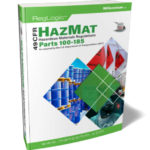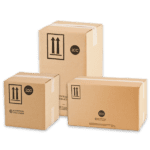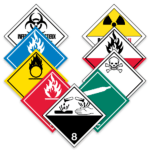 PHMSA Publishes Notice of Proposed Rulemaking for “Miscellaneous Amendments”
PHMSA Publishes Notice of Proposed Rulemaking for “Miscellaneous Amendments”
Who doesn’t love the term “miscellaneous?” It covers so many things, from the stuff in your kitchen drawer to hazardous materials that don’t fit into the main eight classes of dangerous goods. And it’s also handy when regulators have several important but unrelated changes to make. For example, the Pipelines and Hazardous Materials Safety Administration (PHMSA) of the U.S. Department of Transportation (DOT) has published a new proposed set of “miscellaneous” amendments to Title 49 of the Code of Federal Regulations (49 CFR).
The Notice of Proposed Rulemaking (NPRM) was published on March 3, 2023, and closed comments on May 2. The reference assigned is 2137-AF49. Remember, NPRMs are proposals, not finalized amendments, so the Final Rule may be different, depending on the enthusiasm of the comments received.
What Are the Proposed Changes?
What are the miscellaneous changes being proposed? Although they are quite broad-ranging, there does seem to be an emphasis on Class 2, Gases, and the topic of “incorporating standards by reference.”
Incorporation by reference is defined by Wikipedia as the “act of including a second document within another document by only mentioning the second document” and further states that “in American administrative law, incorporation by reference is a drafting tool that enables federal agencies to give legal effect to materials that are already published elsewhere.” In effect, it takes external standards and by referencing them in the regulation, makes them legally enforceable. PHMSA already has incorporated many references into the “Hazardous Materials Regulations” (HMR) of 49 CFR – from international standards like the UN Recommendations on the Transport of Dangerous Goods to commercial or industry standards, such as those from the American Society of Mechanical Engineers (ASME).
What are these miscellaneous changes being proposed? First of all, for gases in Class 2:
- Increasing the packaging options in the transportation of compressed natural gas in cylinders.
- Streamlining the approval application process for the repair of specific DOT specification cylinders.
- Clarifying the filling requirements for certain cylinders used to transport hydrogen and hydrogen mixtures.
Some of the changes will improve hazard communication (marking/labeling and shipping documents):
- Improving the harmonization of the HMR with international regulations regarding de minimis quantities (1 mg or 1 g or less) of toxic materials in Division 6.1.
- Provide greater flexibility and accuracy in hazard communication by allowing additional descriptions for certain gas mixtures.
References to be incorporated include:
- Compressed Gas Association (CGA) publication C-20-2014, “Requalification Standard for Metallic, DOT and TC 3-series Gas Cylinders and Tubes Using Ultrasonic Examination,” Second Edition, which will eliminate the need for some existing DOT special permits and allow alternative methods for the requalification of cylinders.
- The updated Appendix A of CGA publication C-7-2020, “Guide to Classification and Labeling of Compressed Gases,” Eleventh Edition.
- CGA publication C-27-2019, “Standard Procedure to Derate the Service Pressure of DOT 3-Series Seamless Steel Tubes, First Edition.”
- CGA publication CGA C-29-2019, “Standard for Design Requirements for Tube Trailers and Tube Modules, First Edition.”
- CGA publication CGA V-9-2019, “Compressed Gas Association Standard for Compressed Gas Cylinder Valves, Eighth Edition.”
As always, lithium batteries find their way in, with a grammatical clarification that the exemption from the lithium battery mark requirement for button cells installed in equipment is not dependent on the number of button cells present in the equipment.
Other changes would include:
- Improving international harmonization by including the definition of “liquid” found in the European Union agreement concerning the International Carriage of Dangerous Goods by Road (ADR).
- Updating certain references for explosives from the Institute of Makers of Explosives (IME). These documents currently incorporated by reference but have been updated recently, and the new editions must be referenced.
What Do You Need to Do about This?
First, remember that these are proposed, not finalized changes. A good practice for stakeholders is to read the NPRM and determine how the changes would affect their operations. If there are concerns, stakeholders should let PHMSA know through their comment portal. But don’t change your operations or procedures until a Final Rule has been published. Publication sometimes can be done quickly, but usually reviewing comments and making necessary changes will take a period of months (or, for contentious changes, even years).
ICC the Compliance Center will, of course, monitor this new requirement as PHMSA progresses through the development process. If you have any questions, contact one of ICC Compliance Center’s Regulatory Experts. We can advise you on current and upcoming regulations.
Stay up to date and sign up for our newsletter!
We have all the products, services and training you need to ensure your staff is properly trained and informed.
 49 CFR Publications |
 UN Approved UN ApprovedPackaging and Boxes |
 Hazard Class Labels |
Sources:
Federal Register, March 3, 2023, https://www.federalregister.gov/documents/2023/03/03/2023-03366/hazardous-materials-adoption-of-miscellaneous-petitions-and-updating-regulatory-requirements
Wikipedia, 2023, “Incorporation by Reference,” https://en.wikipedia.org/wiki/Incorporation_by_reference

 PHMSA Publishes Notice of Proposed Rulemaking for “Miscellaneous Amendments”
PHMSA Publishes Notice of Proposed Rulemaking for “Miscellaneous Amendments”



